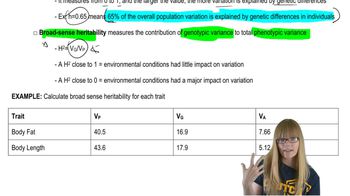Here are the essential concepts you must grasp in order to answer the question correctly.
Autosomal Recessive Inheritance
Autosomal recessive inheritance refers to a pattern where two copies of a mutated gene (one from each parent) are necessary for an individual to express a genetic disorder. In the case of sickle cell disease (SCD), individuals who are homozygous for the mutant β-globin gene allele exhibit the disease, while heterozygous individuals (carriers) do not show symptoms but can pass the allele to their offspring.
Recommended video:
Hardy-Weinberg Principle
The Hardy-Weinberg principle provides a mathematical framework for understanding genetic variation in a population at equilibrium. It states that allele and genotype frequencies will remain constant from generation to generation in the absence of evolutionary influences. This principle can be used to estimate carrier frequencies in populations by applying the equations p² + 2pq + q² = 1, where p and q represent the frequencies of the dominant and recessive alleles, respectively.
Recommended video:
Carrier Frequency Calculation
Carrier frequency refers to the proportion of individuals in a population who carry one copy of a recessive allele for a genetic disorder. To calculate the carrier frequency for SCD, one can use the prevalence of the disease (homozygous individuals) to determine the frequency of the recessive allele (q) and then apply the formula 2pq to find the frequency of carriers (heterozygous individuals), where p is the frequency of the dominant allele.
Recommended video:
 Verified step by step guidance
Verified step by step guidance Verified video answer for a similar problem:
Verified video answer for a similar problem:

